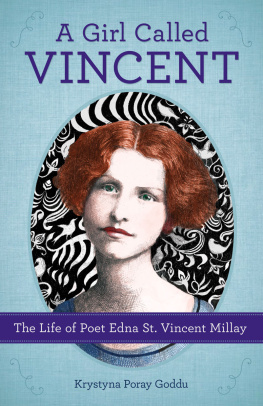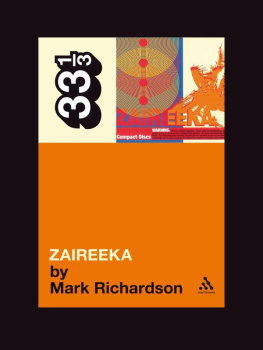
The author and publisher have provided this e-book to you for your personal use only. You may not make this e-book publicly available in any way. Copyright infringement is against the law. If you believe the copy of this e-book you are reading infringes on the authors copyright, please notify the publisher at: us.macmillanusa.com/piracy.
CONTENTS
For Rosemary Knower,
Vincenti dabo ei manna abscondium
Revelation 2:17
PREFACE
This book is based upon unpublished diaries, journals, and letters to and from Edna St. Vincent Millay that have been read by no more than four people since they were written more than half a century ago. These include the poets sister, Norma Ellis, who jealously guarded the documents until her death in 1986, and possibly one other biographer whom she engaged to write a book in the 1970s.
When I discovered in 1999 that these documents had landed at the Library of Congress unprocessed but might nevertheless be made available to a biographer under certain conditions and constraints still dictated by the poets estate, I lost no time in securing the necessary legal permissions. I arrived at the Library of Congress Reading Room in midsummer to find six tall filing cabinets stuffed with twenty thousand items: papers, books, and photographs, in no discernible order. The librarians were apologetic, resourceful, and tirelessly accommodating. I dived into that welter of twentieth-century history and Millays private life and did not come up for air until autumn, when I had answered for myself certain questions that had haunted me since I was a boy and first read Millays poetry. These were the exact riddles that troubled Edmund Wilson, her friend and one of her lovers, the same questions that had been raised, or avoided, by the six biographers whose books about Millay had been published, from Elizabeth Atkins in 1936 to Anne Cheney in 1975. (More recent biographers of Millay have been discouraged by the inaccessibility of the poets papers.)
Who was the girl who wrote Renascence, that precocious marvel of twentieth-century poetry? Out of what reflection, childhood trauma, or spiritual odyssey did it come? Who were Millays lovers, the men and women who inspired the unforgettable sonnets? And after such a public career (she was one of the few American poets to become a celebrity), why did she disappear into seclusion after 1940?
The answers are there, in that slippery mountain of fading, crumbling literature, legal and medical records, and canceled checks. It was my privilege, during months of such excitement that often my hands trembled, to get a rare view of a poets psyche.
* * *
She was Americas foremost love poet, a poet of the erotic impulse and erotic condition whose finest lyrics invite comparison with the sonnets of Sir Philip Sidney and Elizabeth Barrett Browning, and the amorous verses of Catullus and Horace. She saw herself in the tradition of English and European classicism, and those poets were her models, as she wrote:
What lips my lips have kissed, and where, and why
I have forgotten, and what arms have lain
Under my head till morning; but the rain
Is full of ghosts tonight, that tap and sigh
Upon the glass and listen for reply,
And in my heart there stirs a quiet pain
For unremembered lads that not again
Will turn to me at midnight with a cry.
Thus in the winter stands the lonely tree,
Nor knows what birds have vanished one by one,
Yet knows its boughs more silent than before:
I cannot say what loves have come and gone,
I only know that summer sang in me
A little while, that in me sings no more.
(Sonnet XLII)
The American poets who followed herher friends Elinor Wylie and Louise Bogan, and Bogans friend Theodore Roethkeeach wrote individual love poems of great beauty. But no one else managed to sustain an inspiration like Millays, beginning with Bluebeard, written in 1916, and culminating in the book-length sonnet sequence Fatal Interview in 1931.
Of the American poets who preceded herPoe, Whitman, and Dickinsonthe love poems of all three suffer from varying degrees of abstraction; only the Whitman of Calamus preserves the heat of the body in lovemaking. Yet some of his verse lacks lyric concentration. Such heat as his love poems generate is sometimes dissipated in a frame too loosely knocked together to hold them. In the case of Poe, on the other hand, or Dickinson, the most perfect architecture serves as no more than a haunted house for lovers who had less substance in life than in art.
Millays lovers were flesh-and-blood men and women, and her sonnets preserve them in vivid detail:
Love me no more, now let the god depart,
If love be grown so bitter to your tongue!
Here is my hand; I bid you from my heart
Fare well, fare very well, be always young.
As for myself, mine was a deeper drouth:
I drank and thirsted still; but I surmise
My kisses now are sand against your mouth,
Teeth in your palm and pennies on your eyes.
(from Fatal Interview )
If she had written no poems but the love poems, Millay would nonetheless warrant our serious consideration. For after all, when we think of poetry do we not often think first of love poems? Of Sappho and Swinburne? Of Marlowes Come live with me and be my love, Shakespeares Shall I compare thee to a summers day? Of Dantes Beatrice and Petrarchs Laura and Yeatss fiery Maude Gonne? Cultures are distinguished and measured, and nations are characterized by their love poems, their approach to this passion compared to which the rose seems crude and the perfume of violets like the sound of thunder (Caid Ali). Compared to the French, Latin, English, Italian, and Spanish literatures, our American tradition offers very little love poetry. Our major poets of the twentieth centuryT. S. Eliot, Marianne Moore, Robert Frost, and Wallace Stevenstogether did not produce three love poems comparable to Millays Pity me not because the light of day, Love Is Not All: It Is Not Meat Nor Drink, or this, from Fatal Interview:
Not in a silver casket cool with pearls
Or rich with red corundum or with blue,
Locked, and the key withheld, as other girls
Have given their loves, I give my love to you;
Not in a lovers knot, not in a ring
Love in the open hand, no thing but that,
Ungemmed, unhidden, wishing not to hurt,
As one should bring you cowslips in a hat
Swung from the hand, or apples in her skirt
The modernist temperament of Eliot, Moore, Frost, and Stevens shrank from such outpourings. We have to step down to the minor poets (minor by current academic consensus) such as e. e. cummings, John Crowe Ransom, William Carlos Williams, and H.D., to find love poetry of enduring value, almost as if the heat of their passion had made them unfit for the American Pantheon of Major Poets. There is that much of the Puritan still weighing upon the arbiters of such matters.
But Edna St. Vincent Millays contribution did not begin, nor did it end, with her love sonnets. In 1912, at the age of twenty, she published Renascence, a 214-line poem, in a literary annual called The Lyric Year. It is a visionary narrative, a cosmic love poem, recounting a spiritual epiphany. The poems impact was sensational and enduring. In America it has always been extremely difficult to cause a sensation by publishing a poem. William Cullen Bryant did it in 1817 when he was seventeen with Thanatopsis, widely regarded as the first important poem written by an American. In 1845 Poe managed it with The Raven, and in 1899 a now largely forgotten poet named Edwin Markham made a sensation with a sentimental celebration of the workingman called The Man with the Hoe. After Millays Renascence no individual poems of merit have registered as public events, excepting Eliots The Waste Land and Allen Ginsbergs Howl. With the exception of Markhams poem, all of these works are acknowledged classics, appreciated for their intrinsic value as well as their cultural influence. Each was proof of genius. Each spoke for its time. To have written any one of them guaranteed its author a place in literary history.













